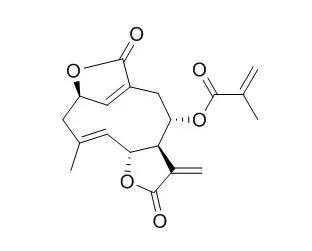| Description: |
Deoxyelephantopin has anti-inflammatory, hepatoprotective, and wound healing activities; it also has antitumor activity, by inhibiting metastatic, inducing apoptosis, modulating oxidative stress , STAT3/p53/p21 signaling, MAPK pathway, PI3k/Akt/mTOR pathway, caspase cascades, and ROS . |
| Targets: |
ROS | Bcl-2/Bax | Caspase | p53 | p21 | PI3K | mTOR | Akt | STAT | p38MAPK | JNK | ERK | ROS | P450 (e.g. CYP17) | MMP(e.g.TIMP) | NF-kB | EGFR |
| In vitro: |
| Food Chem Toxicol. 2013 Oct;60:98-108. | | Evaluation of in vitro cytochrome P450 induction and inhibition activity of deoxyelephantopin, a sesquiterpene lactone from Elephantopus scaber L.[Pubmed: 23876819 ] | Drug metabolism involving cytochrome P450 (CYP) enzymes is a key determinant of significant drug interactions.
METHODS AND RESULTS:
Deoxyelephantopin was evaluated for its effects on the expression of mRNAs encoding CYP1A2, CYP2D6 and CYP3A4, and protein expression and resultant enzymatic activity. The mRNA and protein expression of cytochrome isoforms were carried out using an optimized multiplex qRT-PCR assay and Western blot analysis, respectively. Human CYP3A4 protein expression was determined using an optimized hCYP3A4-HepG2 cell-based assay and the enzymatic activity was evaluated using P450-Glo™ CYP3A4 assay. The molecular interaction and possible inhibition of Deoxyelephantopin of the CYP3A4 enzyme was determined in silico and further validated using substrate-specific CYP3A4 inhibition assays. Deoxyelephantopin produced no significant effect on the CYP1A2 and CYP2D6 mRNA and protein expression. However, it has a weak induction effect on CYP3A4 at the transcriptional level.
CONCLUSIONS:
In silico docking simulation showed that Deoxyelephantopin has a weak interaction with CYP3A4 enzyme and it minimally affects the metabolism of CYP3A4 substrates. Deoxyelephantopin is not an in vitro CYP1A2 and CYP2D6 inducer. It is both a weak in vitro CYP3A4 inducer and inhibitor and is unlikely to elicit a clinically significant effect in human. | | Nat Prod Res. 2015 Feb 17:1-5. | | Anti-metastatic effect of deoxyelephantopin from Elephantopus scaber in A549 lung cancer cells in vitro.[Pubmed: 25686703] |
METHODS AND RESULTS:
In this study, we focused on the in vitro anti-metastatic effects of Deoxyelephantopin (DOE), a sesquiterpene lactone from Elephantopus scaber on lung cancer A549 cells. DOE significantly decreased the metastatic potential of A549 cells as demonstrated by transwell invasion and migration assay. DOE inhibited the expression of matrix metalloproteinase-2 (MMP-2), MMP-9, urokinase-type plasminogen activator and urokinase-type plasminogen activator receptor at transcript level. Tissue inhibitors of metalloproteinase-2 (TIMP-2) mRNA levels was up-regulated in A549 tumour cells without any change in TIMP-1 expression after DOE treatment. DOE inhibited the protein levels of p-ERK1/2 and p-Akt in A549 cells but it activated p-JNK, p-p38 protein expression. NF-κB and IκBα expressions were down-regulated in DOE-treated cells.
CONCLUSIONS:
All these results demonstrated that DOE has shown anti-metastatic activity against A549 tumour cells. |
|
| In vivo: |
| Indian J. Pharmacol., 2005, 37(4):238-42. | | Wound healing activity of the leaf extracts and deoxyelephantopin isolated from Elephantopus scaber Linn.[Reference: WebLink] | To evaluate the wound healing activity of the leaf extracts and Deoxyelephantopin isolated from Elephantopus scaber Linn.
METHODS AND RESULTS:
The effect of aqueous ethanol extracts and the isolated compound Deoxyelephantopin from E. scaber Linn. (Asteraceae) was evaluated on excision, incision, and dead space wound models in rats. The wound-healing activity was assessed by the rate of wound contraction, period of epithelialization, skin-breaking strength, weight of the granulation tissue, and collagen content. Histological study of the granulation tissue was carried out to know the extent of collagen formation in the wound tissue. The ethanol extract and the isolated constituent Deoxyelephantopin of E. scaber promoted wound-healing activity in all the three wound models. Significant ( P <0.01) increase in the rate of wound contraction on day 16 (98.8%, P <0.01), skin-breaking strength (412 g, P <0.01), and weight of the granulation tissue on day 10 (74 mg/100 g, P <0.01) were observed with Deoxyelephantopin-treated animals. In ethanol extract-treated animals, the rate of wound contraction on day 16, skin-breaking strength, and weight of the granulation tissue on day 10 ( P <0.01) were 92.4%, 380 g, and 61.67 mg/100 g, respectively. Histological studies of the granulation tissue also evidenced the healing process by the presence of a lesser number of chronic inflammatory cells, lesser edema, and increased collagenation than the control.
CONCLUSIONS:
The wound-healing activity was more significant in Deoxyelephantopin-treated animals. |
|






 Cell. 2018 Jan 11;172(1-2):249-261.e12. doi: 10.1016/j.cell.2017.12.019.IF=36.216(2019)
Cell. 2018 Jan 11;172(1-2):249-261.e12. doi: 10.1016/j.cell.2017.12.019.IF=36.216(2019) Cell Metab. 2020 Mar 3;31(3):534-548.e5. doi: 10.1016/j.cmet.2020.01.002.IF=22.415(2019)
Cell Metab. 2020 Mar 3;31(3):534-548.e5. doi: 10.1016/j.cmet.2020.01.002.IF=22.415(2019) Mol Cell. 2017 Nov 16;68(4):673-685.e6. doi: 10.1016/j.molcel.2017.10.022.IF=14.548(2019)
Mol Cell. 2017 Nov 16;68(4):673-685.e6. doi: 10.1016/j.molcel.2017.10.022.IF=14.548(2019)